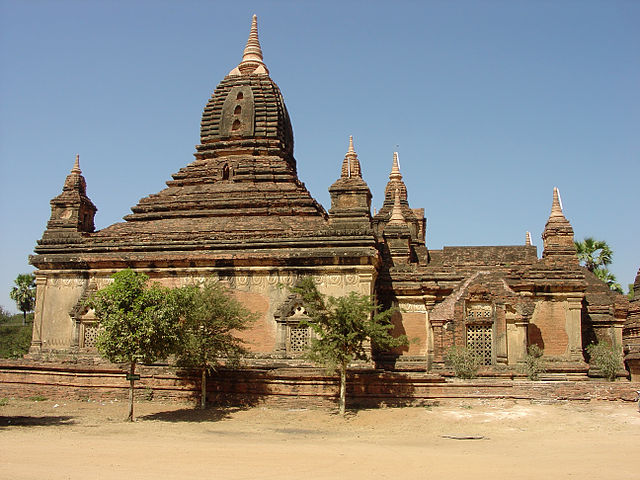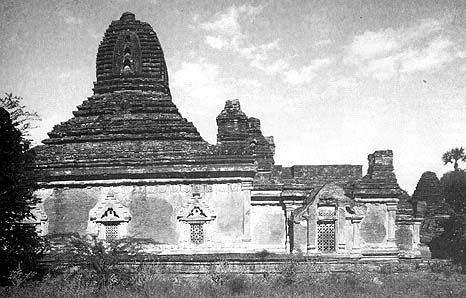

Strachan, p. 72
Myinkaba Gubyaukgyi
South face of the temple
Pagan, 1113

|

Strachan, p. 72 Myinkaba GubyaukgyiSouth face of the temple
|
This is the Gubyaukgyi ("Great Painted Temple") in Myinkaba, not the temple of the same name in Wetkyi-in.
The temple was built by Prince Rajakumar (literally, "Prince
Warrior-King"), the son of Kyanzittha, as an offering (more
technically, a "work of merit") for the salvation of his father.
The idea here is that the karmic advantage accruing from
a person's virtuous actions, such as building and endowing a temple, could be spiritually "passed on" to anyone the merit-maker
designated. (Similarly, in Medieval Europe, pious
kings and princes might endow a church or monastery "for the
soul of" a deceased relative.
The impulse is the same in both cases, although the theologies are quite distinct.)
Three villages of slaves made up the endowment of the temple,
and a consecration ceremony is reported in which Kyanzittha poured
a libation of water to recognize the merit of his son's act.
(Similarly, in
the iconography of the Defeat of Mara, the Earth Goddess wrings
out of her hair a flood of such merit-recognizing libations,
which the Buddha had accumulated in all his past lives).
The towers on the temple are
of the Indian sikhara type, their tips having been
restored sometime after the black-and-white photograph (above was taken, but before my
visit in January of 2004.
The temple's date is recorded on an important
inscription of Rajakumar, written in Pyu, Mon, Old Burman,
and Pali. Although this inscription is sometimes called the
"Rosetta Stone of Burma," such an appellation is very
misleading. The Rosetta Stone provided the key to deciphering
the previously untranslatable writing of Ancient Egypt. In
the case of Rajakumar's stone, however, all four languages were
already known to scholars; the stone's importance is rather
historical than linguistic, since it is the earliest artifact
(so far discovered) on which the Burmese language is written.
Alternate spelling: Kubyauk-gyi.

|

|